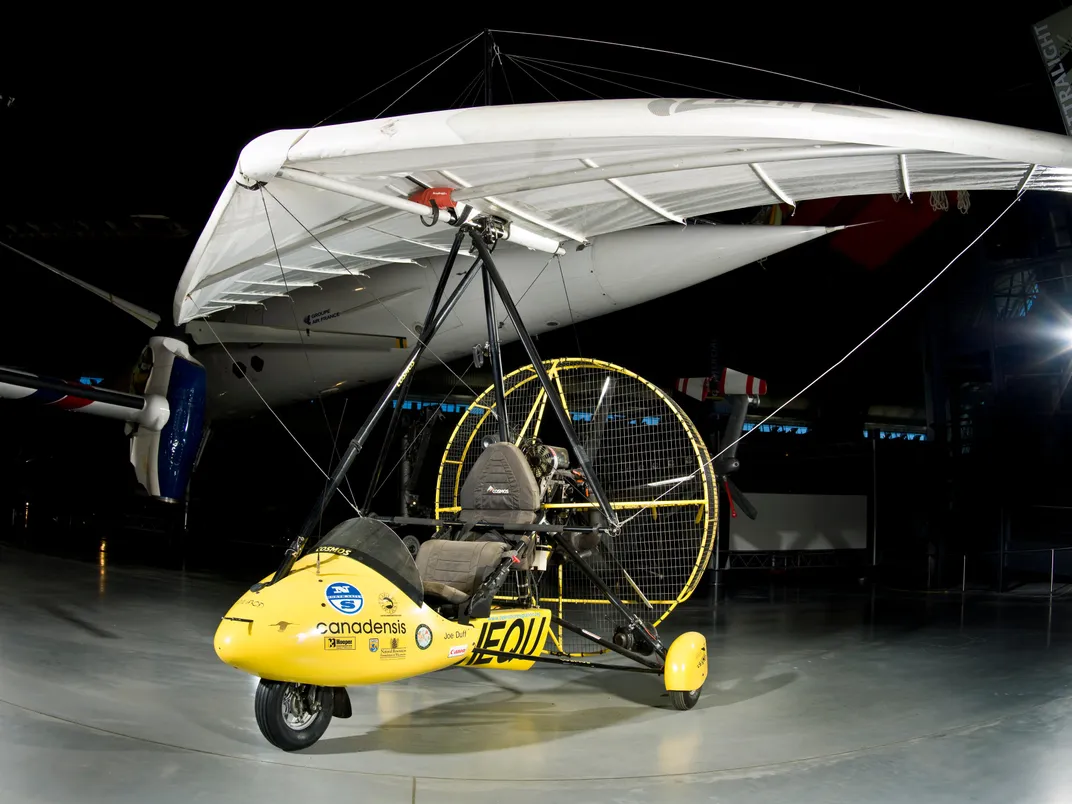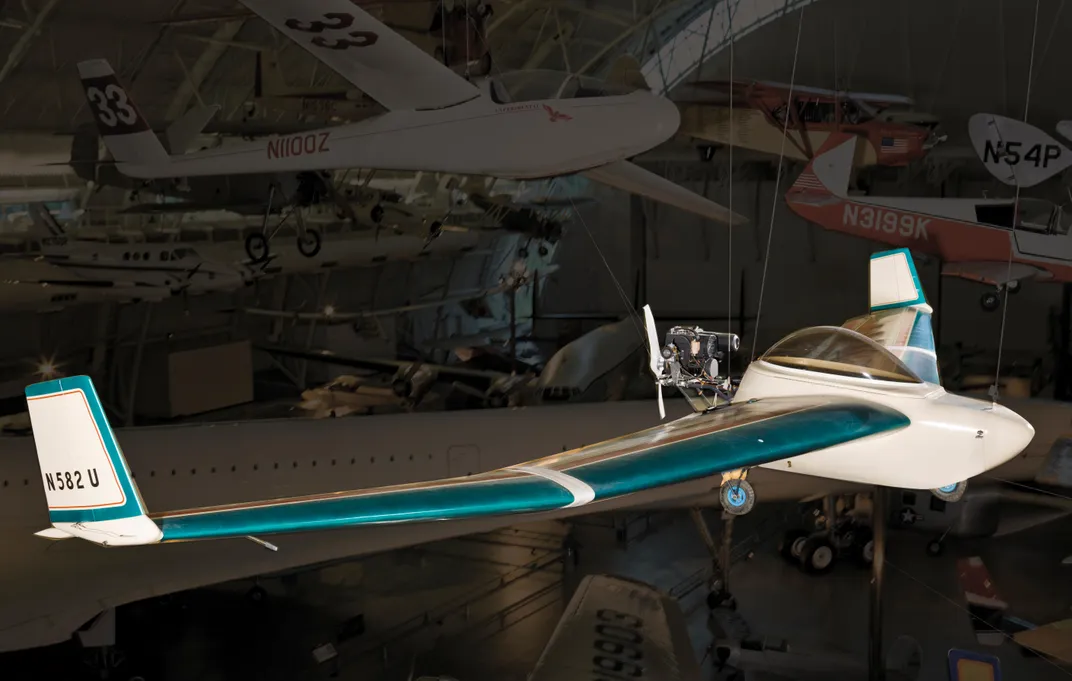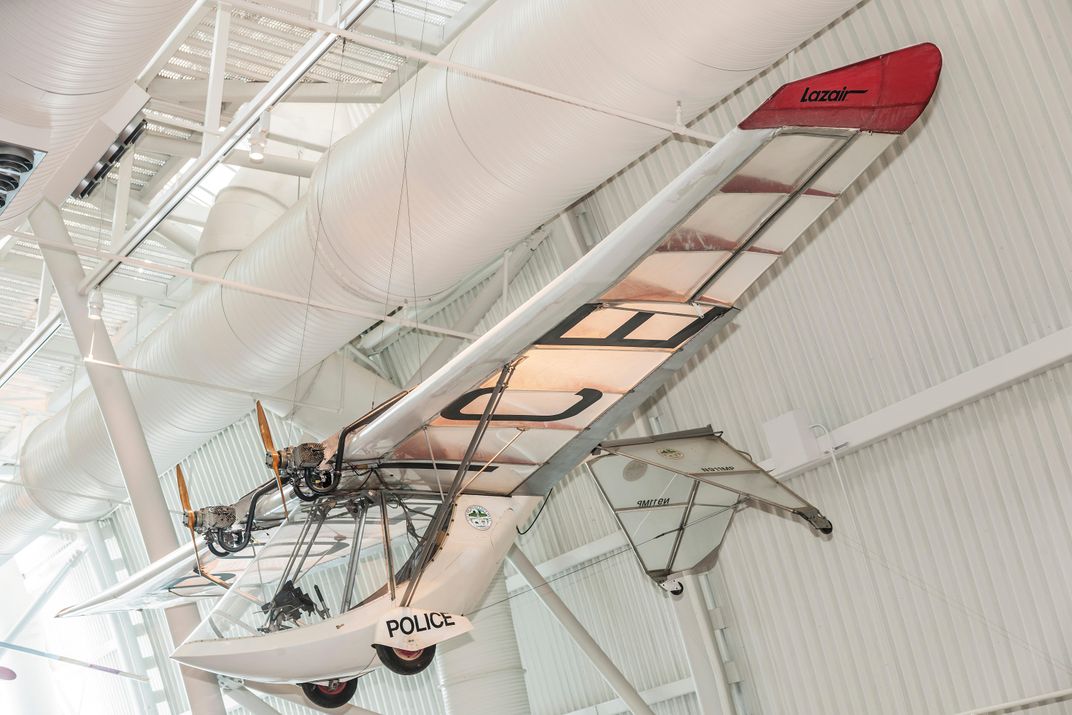The Pioneering Age of Ultralights
Small-engine wonders in the Museum’s collection.
/https://tf-cmsv2-smithsonianmag-media.s3.amazonaws.com/filer/9c/e0/9ce00015-5b51-43bc-9d55-c1f20a6eab39/16e_dj2015_img_8336_live.jpg)
John Moody, an engineer from Ohio, launched the ultralight revolution the same year the National Air and Space Museum opened—in 1976. Considered today the father of ultralights, Moody had combined an Icarus II hang glider and a two-cycle motor, creating a new kind of flier, which he demonstrated at the Experimental Aircraft Association’s fly-in at Oshkosh, Wisconsin. His flights “just set the world on fire,” says Russ Lee, curator of aeronautics at the Museum. “To see a guy put a thing on his back and run a few steps and take off was just magical.”
At the time, flying conventional airplanes built by Cessna, Beech, or Piper was getting to be more and more expensive. “There had been this whole class of people shut out from aviation, people who were handy but just didn’t have the big bucks to go out and take lessons in the conventional way, or rent or buy a conventional airplane,” says Lee. Like Moody, the aspiring pilots who were looking for a faster, cheaper way to get airborne started with hang gliders.
“In the 1970s, hang gliders were very popular,” says Lee. “They were on the coasts where there were a lot of elevation changes and people could fly pretty easily.” Though the sport reached flat areas like the Midwest, there were no suitable launch zones—no cliffs or hilltops to jump from. “People started putting these little sustainer motors on hang gliders. And then other people looked at that and said, ‘Look, we want to use that just to stay up longer, to go fly and find lift.’ ” And the device that made that dream possible was the two-cycle engine. It powered the ultralight movement.
Ultralights are defined by the restrictions imposed by the Federal Aviation Administration’s rule Part 103. The rule restricts ultralights to one occupant, five gallons of gas, an empty weight of 254 pounds, a maximum speed of 63 mph, and a power-off stall speed of 27 mph or less. Exceed any of these criteria and you’re flying an unlicensed aircraft. But keep within the rules and adhere to a list of thou-shalt-not commands (such as no flying from sunset to sunrise, over populated areas or crowds, or in controlled airspace), and your reward is a minimum of FAA oversight. Because ultralight airframes are relatively inexpensive, and pilots aren’t required to have a medical certificate or an FAA license, the community grew rapidly.
“When I came to the Museum in 1982, that year was big for ultralights,” says Lee. “The Museum was interested in following it, and perhaps even collecting a few ultralight airplanes. I was an intern then, and one of the assignments my supervisor gave me was to do a little study on ultralights, and think about what we might acquire.”
As a class, ultralights come in all shapes and sizes, and the Museum’s collection reflects that. The Lazair SS EC is one of the few twin-engine ultralights. The Mitchell U-2 Superwing is a high-aspect-ratio (indicating long, narrow wings) aircraft, almost all wing. The Weedhopper JC-24C, a low-aspect-ratio aircraft, is sometimes described as a flying lawn chair. The Cosmos Phase II, also known as a trike, is essentially a cockpit and motor slung beneath a hang glider wing.
Lee has acquired eight ultralights for the Museum, but not the one John Moody flew for the Oshkosh crowd in 1976. The Museum was offered the ultralight in 1994, but Lee reluctantly turned it down. “It was substantially damaged, missing its original engine, and we already had an Icarus hang glider in the collection,” Lee explains.
Lee is still on the lookout for ultralights to add to the collection and may have a chance at another historic powered parachute. Flying over the swamps of east Texas and Louisiana in 2003, an aircraft resembling John Moody’s simple game changer took part in a historic but grim task: searching for debris from the space shuttle Columbia. The powered parachute, driven by a two-cycle engine, was uniquely qualified for the job. With its cockpit and engine hung beneath a canopy, the craft’s ultra-low speed enabled the pilot to conduct a thorough search, without a helicopter’s downwash, which would have disturbed the ground. Lee is hoping to add that search vehicle to the Museum’s collection.
Although in some quarters, ultralights are aviation’s unloved, at the National Air and Space Museum, they represent one of the foundations of aerospace. “There was a spirit of pioneering,” says Lee about the early days in ultralights. “Guys would go and race each other and try to set records, like fly across the English Channel. It was as though part of aviation was starting up all over again.”
Although it doesn’t meet the FAA’s weight requirement, the 1903 Wright Flyer could be considered the first ultralight in the Museum’s collection. Though modern ultralights are easier to control than the 1903 airplane, they give a pilot a similar sensation in the air: Open to the elements, with minimal structure, and flying low and slow, ultralights recapture the experience of the first airplane pilots.



